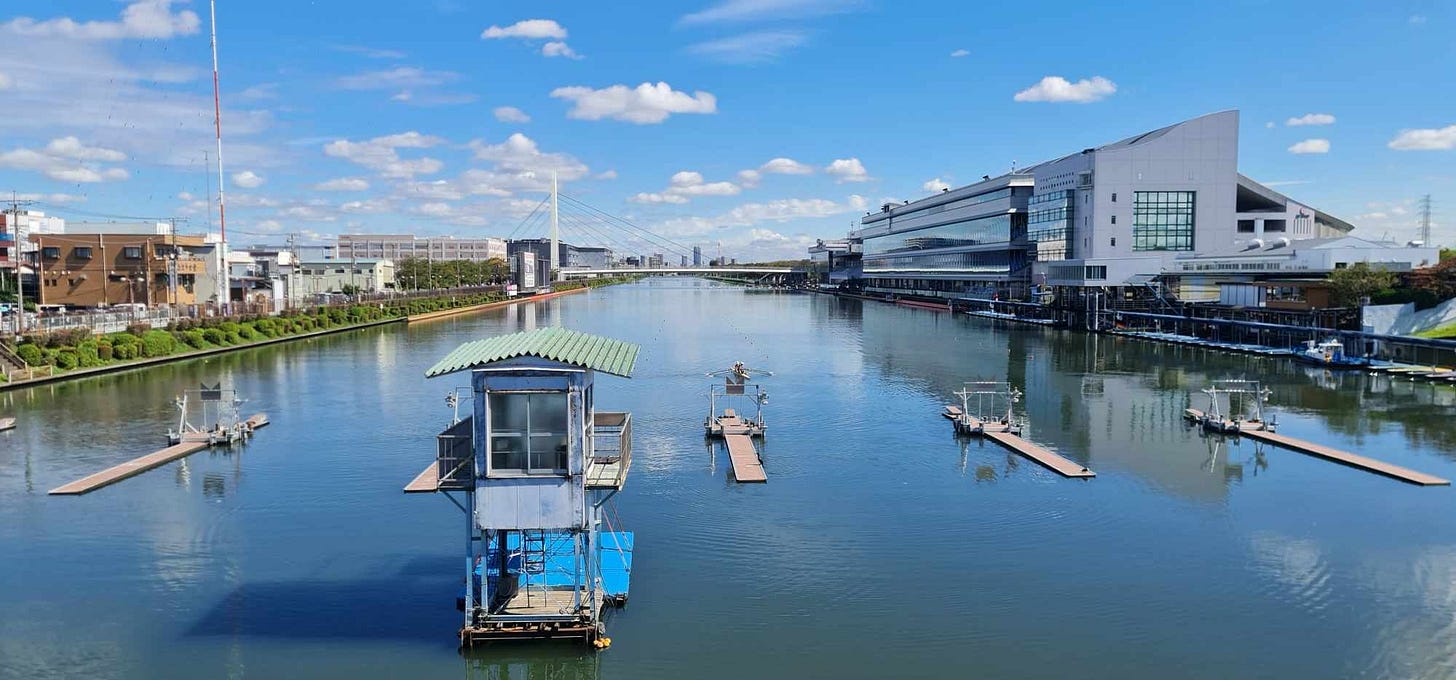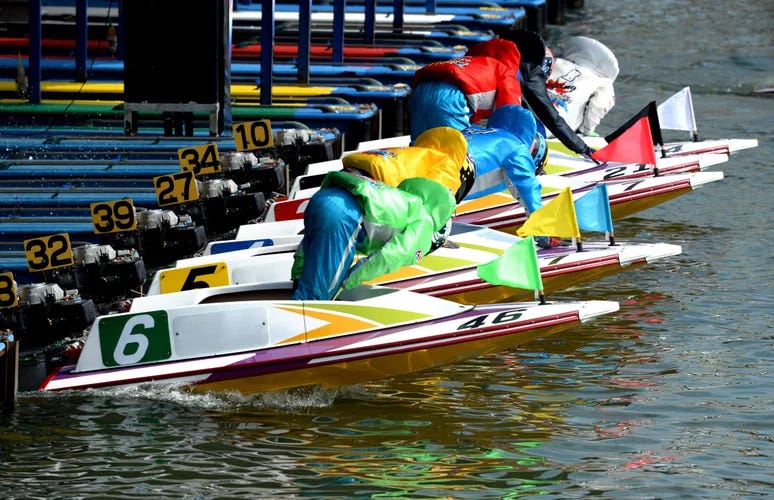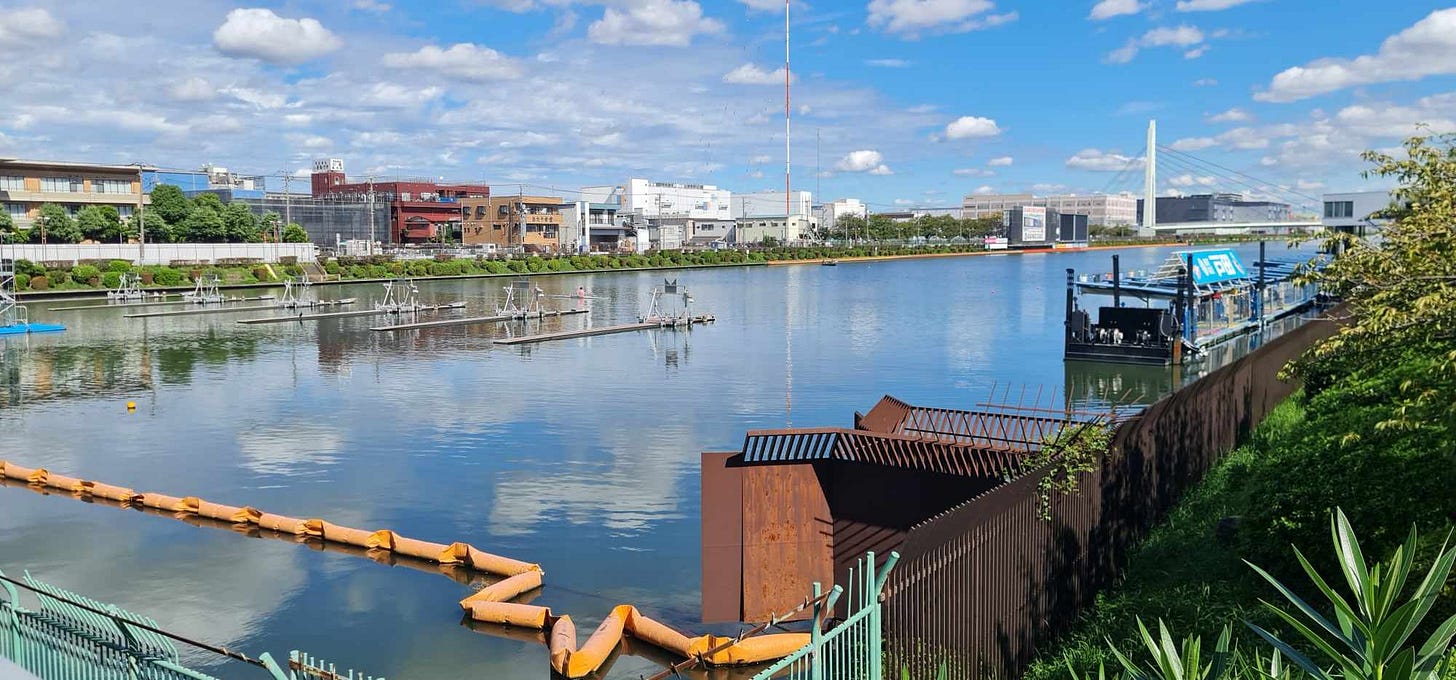You wouldn’t imagine there’d be a lot to say about boat racing. The description is already in the two words: boats racing. Well, strap in, because this post will tell you more than you ever wanted to know about the somewhat underground, overwater sport that has captivated Japan for generations.
What boats can I see?
I get that it’s racing boats, but that is a pretty broad spectrum. It can cover anything from a canoeing race between friends to the superyachts in the America’s Cup. So in Japan what do we mean when we talk about boat racing?
The Japanese phrase is Kyotei which does literally translate back to BOAT RACE (also their main advertising phrase). This consists of hydroplanes racing each other along a circuit.
Hydroplanes are not water-based aeroplanes but rather super speedy motorboats. Their design means that the boat doesn’t just stick to the basics of floating on water, it also sort of floats on air bubbles at high speeds. While I’m unclear on the full physics of lift at play here, the point is that these boats go zoom!
How fast are we talking?
This would be highly irregular on the Japanese circuits, but hydroplanes are most famous as the water vehicle holding the world record speed. Set in Australia in 1978, the record stands at 555km/h and sadly every other record break attempt since then has resulted in the death of the pilot.
For Kyotei, the speeds are usually far more reasonably paced at around 80km/h max speed. A far cry from record-breaking, as the racers do need to factor the 5 other competitors while chasing victory. So where do these events take place?
Here, there, wherever you are
If you’re in Japan and not in the three regions of Tohoku, Okinawa or Hokkaido, you’re already pretty close. There are 24 arenas across the country and each are built on whatever water they can find. Be it artificial lakes, rivers, or out on sea, there is a Kyotei stadium near you calling your name.
The circuits themselves are not wild Escher shapes which bend and turn like Mario Kart, but a standard loop around 2 buoys placed 300m apart. Parity is the name of the game in Kyotei, with every stadium adhering to this identical course with borders of 400m x 150m. To push equality even further, every boat is identically built, and every engine is identical. Before every race, the pilots are assigned a boat by lottery and told to figure the rest out.
You may wonder how exciting a race could be when it involves identical transportation devices going around and around a single set track that is a set distance (not looking at horse racing or NASCAR). Well if you do look at other racing activities (or sports in general), there is a bonus activity that makes them much more exciting. That’s right!
Gambling!
Japan has strict anti-gambling laws for almost all parts of life. In a previous edition, we explored how pachinko has flourished in the absence of legal casinos.
Kyotei may also benefit from government restrictions on gambling. BOAT RACE is one of the kōei kyōgi or four public (legal to gamble on) Japanese sports. These were protected since the post-war period, and include horse racing, bicycle racing, and asphalt speedway motorcycle racing. The betting markets are in effect run by the government, who have enforced the strict race rules. One side-effect has meant that for better or worse, these races have hardly changed since their very first iteration in 1952. Everything from the format, stadium, and even boat design have remained a time capsule of decades gone Japan.
Attending the big boat bonanza
This association with gambling has not endeared the sport to upstanding Japanese citizens. Despite the completely above-board betting, kyotei is not spoken about in polite society and rarely publicised as another national pastime. The stereotype is that only criminals and delinquents participate in these events, so naturally I found a day to observe myself.
While each stadium is identical in build and stature, the one I visited was Toda in Saitama. Hosting races for half the week every week, I had low expectations for the quality of entertainment. The entry price also warranted concern, a princely 100 yen.
Going past factories and warehouses, suddenly the landscape opens to a small embankment with an imposing entrance building. Tucked away from the “centre” of tourist activity, the race can feel like a daunting cultural experience to attend.
The ushers direct you up escalators, until you hit the ticket sales. You can buy “premium” seats, or the regular 100 yen general stands. I suspect the absurdly large viewing platforms are to give the impression of grandeur, rather than actually to reach a capacity.
Finding a seat among the punters, I was ready to take part in the spectacle. I watched the first race go, thrilling in the pilots’ close quarter turns. The speed of the racing felt a lot faster than the listed 80km/h.
The audience was unfazed, and the motley crowd did not show whether they had backed a winner or loser. None of the cheering associated with audience sports had emerged, instead a stoic silence as people watched the orchestrated maneuvers of the professionals.
On the following race, I chose to join the betting action. This time the race had a lot more at stake. Did this make the race better? I am biased, so no. It made for a very exciting but ultimately disappointing race. For full transparency, this author did not recoup the 100 yen entry fee.
What I did come away with was a fuller appreciation for the dedication and skill it takes to become a professional boat racer.
How to be a boat racer
If the prospect of racing at high speeds on water for an audience of gamblers appeals to you, then I know the perfect place to study. The Boat Race Academy in Yamato is the officially sanctioned place to learn. Their application question acts as both an advertisement and a warning to potential applicants “Where else can a 15 year-old with no experience become a professional athlete?”
Beyond that rigorous screening process, they do also have a weight requirement (under 57kg for boys, under 52kg for girls), and an eyesight exam. After that, a few more tests that mimic high school with Japanese, mathematics, social studies and science, with a couple personality interviews, then you’re ready. When all is said and done, the academy is a surprisingly popular option for people, with over 2000 applicants yearly for one of only 60 places.
Assuming you’ve beaten out the competition and been selected, the program does not seem like a stroll in the waterpark. For the entirety of the one-year course, it seems every day is monitored closely and regimented from 6am to 10pm. The academy doesn’t shy away from this fact, with a regular day’s schedule proudly displayed.
6am: wake up
6.10am: roll call
6.30am - 7am: cleaning
7am - 7.30am: breakfast
7.30am - 8am: flag raising (for the Japan flag and boat race academy)
8am - 12pm: work (I assume this means boat race training)
12pm - 1pm: lunch
1pm - 4.55pm: work
4.55pm: flag descending
5pm - 5.45pm: dinner
5.45pm - 7pm: free time!
7pm - 9pm: bathing and free time!
9pm - 9.30pm: cleaning
9.30pm: roll call
10pm: lights out
Day ? of 365
I think the school has done a great job at filtering out people who are not ready for a boat race life. For me, being a part of the boat race audience was enough immersion, and I don’t envisage becoming a boat racer anytime soon. For people interested in the quickest route to becoming a professional athlete, please attend a boat race when visiting Japan before enrolling into the academy and making that life decision.








Another interesting and in-depth article, Leon!
I really liked this line at the start: “... about the somewhat underground, overwater sport...”
https://www.instagram.com/reel/CumjGbeI7X5/?igshid=MzRlODBiNWFlZA==
these are definitely on a different boat not sure if they are racing for everything else 🤠